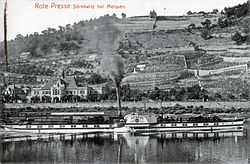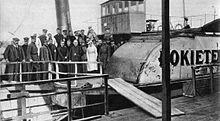Princess Luise (ship, 1895)
|
Paddle steamer Aussig in Sörnewitz
|
||||||||||||||||||||
|
||||||||||||||||||||
|
||||||||||||||||||||
|
||||||||||||||||||||
|
||||||||||||||||||||
The paddle steamer Princess Luise was built in 1895 in the Blasewitz shipyard. The ship was laid with the hull number 37 on the keel . In 1903 it was named the Crown Princess . In 1904 the name was changed to Aussig . In 1917 it was renamed Ulderup , 1919 Łokietek and 1934 Faust .
The time until 1918
The ship was christened at Pentecost 1895. Luise of Austria-Tuscany , who gave the ship its name, carried out the christening herself. After commissioning as a smooth deck steamer , the ship drove for the Saxon-Bohemian Steamship Company (SBDG). After the death of King Albert , her husband Friedrich August rose to become crown prince and she became crown princess. As a result, the ship was renamed Crown Princess Luise in 1903 . In 1904, after an affair between Crown Princess Luise and her escape from the Dresden court, the ship was renamed Aussig . On October 10, 1917, the ship was rented by the German Army and under the name Ulderup , named after today's Danish town of Ulderup , relocated to the Vistula for war use . Here it was subordinated to the field railways department of the German Army in Warsaw . On April 22, 1918, the Warsaw shipping company Maurycy Fajan submitted an offer to buy. This was rejected by the SBDG as there was a ban on the sale of German ships abroad. On November 4, 1918 there was an offer to buy from the shipowner Chaim Rogozik from Płock . This offer was also rejected for the same reason.
The time in Polish ownership
On January 25, 1919, the shipping department of the field railroad, based in Berlin, terminated the lease. On August 12, 1919 the shipping company Chaim Rogozik renewed the purchase offer and offered 300,000 marks for the ship. This was again rejected for the reasons mentioned. In the autumn of 1919, the Warsaw Transport and Shipping Company took over the ship and renamed it Łokietek . The ship was used on the Gdansk – Warsaw route. In November 1919 a paddle wheel was damaged due to ice drift. The ship had to be towed to the shipyard in Płock for repairs. Here, the ship received a steam steering engine and a wheelhouse as part of the repair .
The question of ownership was not clarified on the German side. On October 30, 1920, the SBDG demanded 1,322,860.97 marks outstanding rent from the German gentleman. It was not until 1921 that the Reich Treasury Department paid 350,000 marks to the SBDG in a settlement.
During the Polish-Soviet War it was used as a hospital ship between 1920 and 1922. In August 1920 Achille Ratti was Pope Pius XI from 1922 . , on the ship that had just returned from a voyage to Modlin Fortress . From 1922 it was taken over by the United Polish Shipping Company. In 1924 the shipowner Juliusz Dunin-Holecki from Płock took over the ship. After the unification of the Polish shipping companies, the Polish inland shipping company "Vistula", based in Warsaw, took over the ship in 1927. In October 1928 the Włocławek landed. The ship was leaked. It was again repaired in the Płock shipyard. In 1934 the name of the ship was changed to Faust . From 1936 the bank Gospodarstwa Krajowego (BGK) was the ship owner. In 1937 the ship was taken over by the Warsaw shipowner Edward Leszczynski. The fist can also be seen in a short passage from the Polish film Ludzie Wisły (People of the Vistula), shot in 1938 . After the outbreak of the Second World War , it was incorporated into the Weichsel Reederei GmbH in 1940 . Nothing is known about the use of the ship until 1944. It was sunk by German artillery during the military conflict during the Warsaw Uprising in August / September 1944. At that time it was located on the Wioślarskiej waterfront in the Czerniaków district . In 1947 the ship was lifted and scrapped.
The steam engine
The steam engine was an oscillating, high-pressure, two-cylinder composite steam engine with injection condensation. Like the single-flame tube cylinder boiler, it was built by the Übigau shipyard of the Deutsche Elbschiffahrts-Gesellschaft, Ketten, with factory no. 93. The power was 140 hp. The steam boiler had a steam pressure of 9 bar .
Captains of the ship
- Gustav Adolf Thieme 1896–1897
- Friedrich August Streidt 1898–1899
- Gustav Hermann Protze 1900–1917
literature
- Shipping calendar for the Elbe area from 1896 to 1914
- Shipping calendar for the Elbe area and the Märkische Wasserstrassen from 1915 to 1920

